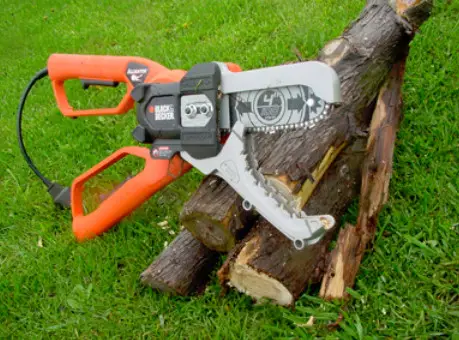You only need a few trees on your property before cutting up limbs and branches makes it to the top of your to-do list. And depending on your situation, your temperament and the number of trees you’ve got, there are a few different types of pruning tools for you to consider.
Hand Tools
Every garden needs some garden tools. I figure that if you can make your garden look better without using electricity or gasoline, while also getting exercise at the same time, then that’s a good deal.
In my own garden shed, I keep the following garden tools:
- A couple of Japanese pruning saws
- A pair of long-handled loppers for trimming branches up to about 1-inch in diameter.
Chainsaws
But there comes a time when branches become too big and numerous for muscle power alone, and that’s where you might consider a chainsaw.
I like chainsaws. They’re fast, effective, and they make me feel all-powerful, in a red-plaid-jacket sort of way. But you never get superhuman powers like this without paying a price.
Besides being noisy, chainsaws are also dangerous enough to warrant special care when it comes to handling them. And this fact frightens some people, as it should. But what else can you expect from a power tool with more than two feet of sharp, exposed teeth spinning around furiously at one end?
If the thought of wielding a chainsaw and trimming your tree branches is too ambitious for your do-it-yourself skills try a Professional Landscaper from casaGURU. All of them are licensed, insured and homeowner rated.
Black & Decker Alligator Lopper
 The Black & Decker Alligator Lopper is a variation on the chainsaw theme, without many of the drawbacks. And while this plug-in, $150 electric tool certainly can’t replace a chainsaw when it comes to cutting large logs, the design combines unique features that make it much safer than typical exposed-bar type chainsaws for pruning chores. It’s also surprising effective. In fact, the Alligator is actually the very best tool there is for specific kinds of trimming tasks, and to understand why you need to see how it works:
The Black & Decker Alligator Lopper is a variation on the chainsaw theme, without many of the drawbacks. And while this plug-in, $150 electric tool certainly can’t replace a chainsaw when it comes to cutting large logs, the design combines unique features that make it much safer than typical exposed-bar type chainsaws for pruning chores. It’s also surprising effective. In fact, the Alligator is actually the very best tool there is for specific kinds of trimming tasks, and to understand why you need to see how it works:
- The Alligator has a six-inch long chainsaw bar, but it isn’t fully exposed like on conventional saws.
- Instead, the bar and chain are housed in a cast aluminum shroud with a hinged jaw that swivels from the bottom side.
- You open and close the jaws by working the two tool handles, sort of like a pair of grass clippers.
- Each handle has a trigger and both must be squeezed at the same time for the saw to operate.
This jaw design offers two important functions:
Safety
- The main function is safety. The saw chain itself is only ever exposed when the jaws are open, greatly reducing the chance for accidental contact with a leg or foot or arm.
- Since the jaws grip tightly onto a tree branch and anchor the tool during use, it’s virtually impossible for the Alligator to jump around and kick back during a cut. Sawing action proved fast, smooth and particularly safe during my time working with the tool.
Need to Sharpen Less Frequently
One of the perennial problems with conventional chainsaws is the hassle of sharpening the chain. Even with experience, this job can take a good twenty minutes of effort. And since a freshly sharpened chain becomes hopelessly dull after just a few seconds of contact with the soil, there’s good reason to be concerned when you’re chainsawing branches as they lay on the ground.
- The jaws of the Alligator virtually guarantee that you’ll never make the saw chain dull by accidentally cutting into the dirt.
- That’s because the bottom jaw always sits between the earth and the wood during a cut, keeping the saw chain safe and happy.
- Sure, you’ll need to sharpen the chain eventually, but the machine does a lot of work before that’s necessary.
The world is awash with tool innovations these days, and most of them fall by the wayside, uncopied and forgotten after just a few years. But I have a feeling that combining jaws and a saw chain might just be one of those things that makes it to the big time.